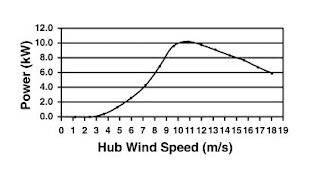Wind turbine cut-in speed means, the lowest wind speed at which the wind turbine will start to generate noticeable electrical output power. If you were to search for a wind turbine, don't consider cut-in wind speed as a primary goal. It is not desirable nor is it preferable to buy a wind turbine with low cut-in .
The reason why you should ignore cut-in speed is that the generator of the wind turbine won't start to charge your battery or battery banks till the output voltage from the alternator is higher than the battery voltage or battery bank.
However, if you were to find a suitable wind turbine and the turbine has a low cut-in wind speed you may consider it since this can produce at least some kind of electrical output power most of the times when wind speed is low and your battery or battery bank is fully discharged.
However, if you were to find a suitable wind turbine and the turbine has a low cut-in wind speed you may consider it since this can produce at least some kind of electrical output power most of the times when wind speed is low and your battery or battery bank is fully discharged.
On the other hand, if you’re designing your own wind turbine, you may not need to worry about cut-in wind speed since you might be able to utilize funneling technique to your wind turbine to increase the wind speed.
